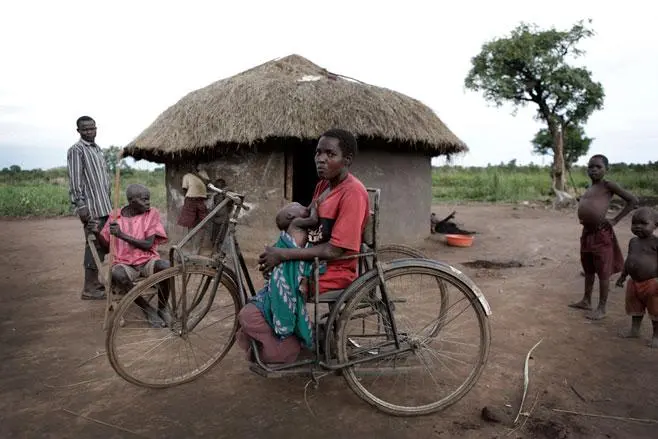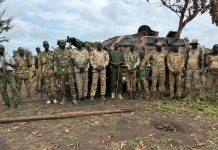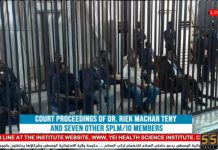By Okello Jesus Ojara
Climate change threatens all of us. But for those of us living with a disability- an estimated 15 percent of the global population –the threat, compounded by discrimination, marginalization, and other pre-existing inequalities is even greater.
Few countries make provisions for the needs of people with disabilities when they make plans for adapting to the effects of climate breakdown, and none mention persons with disabilities in their programmes.
In Northern Uganda, the higher poverty and food insecurity rates amongst people with disabilities, and inadequate housing, tend to heighten their exposure and vulnerability to hazards, which can increase their risk of forced displacement. People with disabilities often face barriers accessing information and resources which limit their knowledge and capacity to adapt to climate change.
Martin Obol, a 43 years-old, a resident of Kal village, Amuru sub county, Amuru district disclosed that the issue of climate change cannot be taken likely since many persons with disabilities have little knowledge and information on how to adapt to climate change.
“We have been living in the dark since we were born, and it seems we have forgotten the inclusion in the climate change adaptation programmes by government,” notes Obol.
“This is worse for some of us who cannot manage to walk or run when hit by the adverse effects of climate change and the situation is worse for those with hearing impairments and the blind who could not access the information about climate change,” Obol told this publication.
According to Denis Lakwonyero, Councilor V for Persons with Disabilities in Gulu district, people with disabilities are more likely to be impacted by disasters, as disaster preparedness programs and early warning systems are often inaccessible-not provided in sign language or audio messages for example; evacuation systems and personnel are not prepared in advance to support people with different impairments.
He further added that people with disabilities may be unable to move out of harm’s way due to the inaccessibility of evacuation paths, absence of support or social exclusion. For those left behind in high risk situations, the loss of support networks increases their vulnerability further.
He further noted that temporary shelter and evacuation centers are often inaccessible to people with physical or visual impairments. Temporary schools might not be accessible for boys and girls with disabilities and teachers might not be trained on how to best include them.
Under the international human rights law, governments have clear obligations to respect, protect, and fulfil the rights of persons with disabilities in the context of their efforts to respond to climate change.
The preamble to the Paris Agreement affirms that “Parties should, when taking action to address climate change, respect, promote and consider their respective obligations on human rights,” including the rights of persons with disabilities, and the Office of the United Nations High Commissioner for Human Rights have each specifically recognized the disproportionate impacts of climate change for people with disabilities and called on States to adopt disability-inclusive human rights based approaches to combating climate change.
The resilience of persons with disabilities in landslide prone areas is not well understood, moreover, these disasters are persistent and this information is vital in enhancing socioeconomic transformation of the livelihoods of persons with disabilities.
Joska Alanyo, a woman with visual impairment told a local radio station during an interview that she cannot no longer feed her five children and there is no one to help her with what to do since she cannot see and those who are visually fine tend to make a fool of her.
“My worries are that I cannot even feed my family, they who can see and have access to climate change information are benefitting at our expense,” she told the radio station.
According to Uganda National Action on physical disability which was invented to build the capacity of persons with disabilities prone areas of Eastern Uganda to advocate for inclusive disaster risk reduction and response policies and programs, in line with CRPD Article 11 (situations of risk and humanitarian emergencies) has a provision for the inclusion of people with disabilities in their programs but most region are left behind.
Joseph Muvawala, the Executive Director, National Planning Authority told this publication that the invisible uncounted people with disabilities are more likely to experience further social exclusion because persons with disabilities have diverse personal characteristics – with differences in gender, age, socio economic status, ethnicity, or cultural heritage.
“The 2014 Uganda census (UBOS 2014) nonetheless estimates that the highest forms of disability are: difficulty remembering; difficulty walking; and difficulty hearing; and the census used only four of six Washington Group Set of Questions ( difficulty walking, seeing, hearing, and cognition),” noted Joseph.
disability by prevalence by category in Northern Uganda (illustration)
He however noted that estimates of disability in Uganda however need to include other forms of disability – e.g. difficulties in communicating and self-care(Washington Group questions), in addition to mental health related disabilities, and other unique challenges faced by categories such as albinos, and little people, who identify as part of the population with disabilities in Uganda.
“Planners should ensure that interventions reach all groups of persons with disabilities, and not only those that are easy to enumerate and to target,” he told this publication.
Government support for people with disabilities
The Government of Uganda has adopted a number of laws and policies pertaining to people with disabilities, including their right to productive and decent work and basic services.
For a long time Uganda has been regularly affected by multiple hazards including droughts, earthquakes, floods, landslides, cholera, Ebola, and COVID – 19 pandemic. Additionally, the strategies being undertaken by the policy are not explicitly stating how persons with disabilities are to be supported to become resilient to disasters.
According to the Uganda- Multi-hazard info graphic of 2022 published by International Organization for Migration (IOM) and presented to the National Disaster Risk management platform hosted by Office of the Prime Minister, they observed that disasters, both natural and human induced, are becoming frequent, and increasing in complexity, consequently affecting more people, livelihoods and systems than ever before.
Organization of Persons with Disabilities (OPDs) through their DRR projects have advocated for inclusiveness of disaster risk reduction programs in Uganda. OPDs have influenced representation of persons with disabilities on the interagency National Platform for Disaster Risk Management hosted by Office of the Prime Minister, representation on District Disaster Management Committees in the districts of Bududa, Kasese and Isingiro.
Although Uganda has several laws and policies on Disaster Management, they are not yet robust enough to address new and emerging challenges. The year 2019 was a trying one because Uganda had to deal with multiple hazards at the same time which greatly exposed high levels of unpreparedness at all levels in the country.
These policies and laws like The Constitution of Uganda, 1995, Article 21 prohibits discrimination against people with disabilities and Uganda is one of the few countries in the world to recognize sign language in its constitution, and the National Policy on Disabilities, 2006, provides a human rights – based framework for responding to the needs of persons with disabilities among others.
The Ministry of Gender, Labour and Social Development coordinates the Uganda Community based Rehabilitations Programme which was adopted in 1992 as a strategy within general community development for rehabilitation, equalization of opportunities and social inclusion of all children and adults with disabilities.





